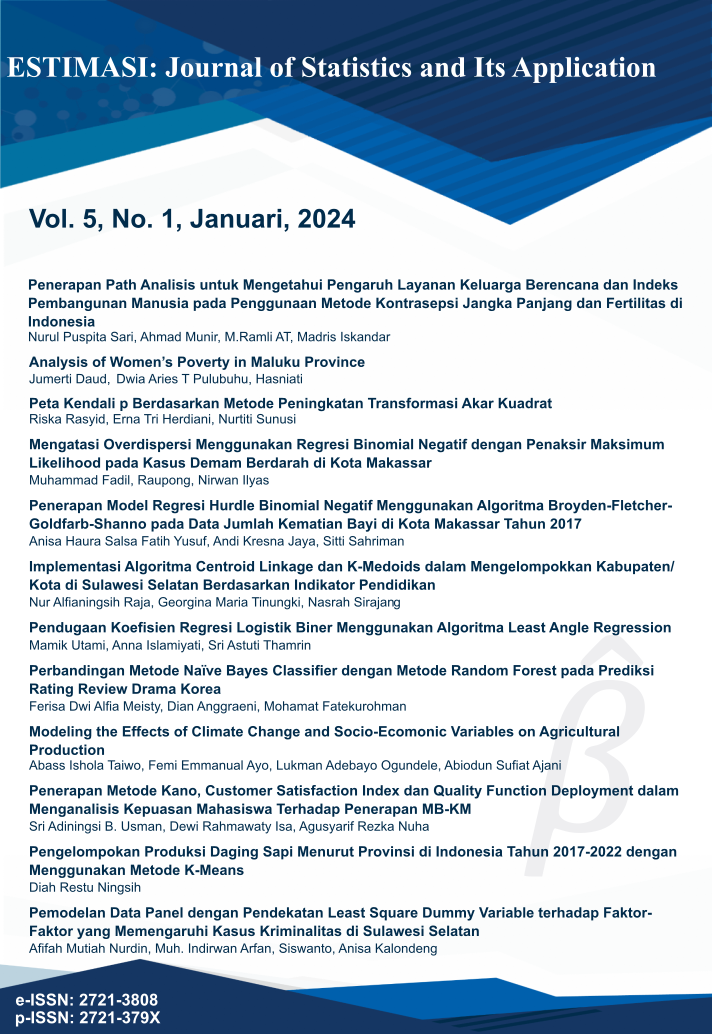Perbandingan Metode Naïve Bayes Classifier dengan Metode Random Forest pada Prediksi Rating Review Drama Korea
Keywords:
korean drama, review, rating, prediction, naïve bayes classifier, random forestAbstract
Korean dramas have very many fans and are spread in various countries. This study aims to determine whether the korean drama is classified as Bagus, Tidak Bagus, or Cukup Bagus and compares two methods, namely the naïve bayes classifier method and the random forest method in predicting korean drama review ratings. This study shows that the naïve bayes classifier and random forest methods are capable of predicting korean drama review ratings. In the prediction review, the random forest method obtained an accuracy value of 89%, while the naïve bayes classifier method obtained an accuracy value of 86%. In rating predictions, the random forest method obtains an accuracy value of 41%, while the naïve bayes classifier method obtains an accuracy value of 40%. The conclusion of this study is that the random forest method is superior and accurate in predicting Korean drama review ratings.
References
Marta, T.E., Ali F., M., & Indriati. Penentuan Rating Review Film Menggunakan Metode Multinomial Naïve Bayes Classifier dengan Feature Selection Berbasis Chi-Square dan Galavotti-Sebastiani-Simi-Coefficient. Jurnal Pengembangan Teknologi Informasi dan Ilmu Komputer, 2019.
Sandag, G. A. Prediksi Rating Aplikasi App Store Menggunakan Algoritma Random Forest. Cogito Smart Journal, 6(2), 2020.
Nurfajriah, H. N, Wina, W., & Rezki Y. Prediksi Rating Drama Korea Menggunakan Algoritma Iterative Dichotomiser 3. Seminar Nasional Informatika dan Aplikasinya, 2017.
Charuchinda, C. IMDb Korean TV Series. TV Series, South Korea (Sorted by Popularity Ascending) - IMDb. [Diakses pada 11 Juni 2022].
Simbar, F. K. .Fenomena Konsumsi Budaya Korea Pada Anak Muda di Kota Manado.Jurnal Holistik, 2016.
Lee, E. J., & Shin, S.Y. When do customers buy online product reviews? Effects of review quality, product type, and reviewer’s photo. Computers in Human Behavior Journal, 31, 356-366, 2014.
Lewis, D. Naive Bayes at forty : The Independence Assumption in Infromation Retrieval. Proceedings of The Truth European Conference on Machine Learning, 4-15, 1998.
Wisdayani, D.S. Perbandingan Algoritma K-Nearest Neighbor dan Naïve Bayes untuk Klasifikasi Tingkat Keparahan Korban Kecelakaan Lalu Lintas di Kabupaten Pati Jawa Tengah. Skripsi. Semarang: Universitas Muhammadiyah Semarang, 2019.
Berry, I. H., & Browne, M. Lecture Notes in Data Mining. USA:World Scientific. 2006.
Primajaya, A., & Sari, B. N. Random Forest Algorithm for Prediction of Precipitation. Indonesian Journal of Artificial Inteligence and Data Mining, 1(1), 2018.
Breiman, L. Random Forest : Machine Learning, 45:5-32, 2001, doi: https://doi.org/10.1023/A:1010933404324.
Downloads
Published
Issue
Section
License
Copyright
It is the author's responsibility to ensure that his or her submitted work does not infringe any existing copyright. Authors should obtain permission to reproduce or adapt copyrighted material and provide evidence of approval upon submitting the final version of a manuscript.


